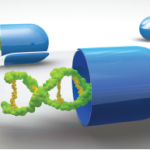The cat-eye syndrome chromosome region, candidate 1 (CECR1) encodes adenosine deaminase 2 (ADA2), which is the major extracellular adenosine deaminase. It’s highly expressed in plasma, can act as a growth factor and has been implicated in the regulation of T cell and macrophage proliferation.
Two studies published in the March 6 online issue of The New England Journal of Medicine describe how a single gene defect in ADA2 can result in vasculopathy overlapping polyarthritis that manifests with a range of vascular and inflammatory phenotypes, including early-onset stroke, systemic vasculopathy and vasculitis.
In the first study, Paulina Navon Elkan, MD, of the Haddasah Medical Center in Israel and colleagues report exome sequencing results of clinically affected families of Georgian Jewish or German ancestry.1 These populations were chosen because they have a high rate of polyarteritis nodosa. The authors report that the ADA2-associated disease is common among individuals of Georgian Jewish ancestry and appears to be due to mutations in CECR1. They also note that mutations in CECR1 extend beyond that ethnic group resulting in polyarteritis nodosa in Turkish patients as well.
“Our results indicate that vasculopathy overlapping polyarteritis nodosa can be caused by reduced activity of ADA2 owing to recessive mutations in the ADA2-encoding gene CECR1,” write Elkan and colleagues in their discussion. “This vasculitis is characterized by highly varied age at onset, severity and organ involvement, even within families and among patients with the same mutations. Manifestations range from severe or fatal systemic vasculitis, or multiple strokes in children, to limited cutaneous manifestations in middle-age persons.”
In the same issue, Qing Zhou, PhD, of the National Human Genome Research Institute in Bethesda, Md., and colleagues published the results of their whole-exome sequencing study of nine patients and their families.2 The patients exhibited a wide spectrum of symptoms, including recurrent fevers, vascular pathology and mild immunodeficiency. The investigators report that all patients have the ADA2 mutation. Dr. Zhou and colleagues go on to propose a new genetic disorder, called “deficiency of ADA2,” that connects the seemingly unrelated symptoms.
Vasculitides are made even more complex by the fact that there are no unequivocal diagnostic criteria. The identification of the ADA2 mutation may be the first step in a gene-based definition of disease that would facilitate diagnosis and characterize polyarteritis nodosa as an immune disorder. Zhou et al propose that the vasculopathy associated with ADA2 mutations may be due to the loss of ADA2 as a growth factor, thus paving the way for problems in early development, as well as problems with the immune system.
“Our data corroborate a role for ADA2 as the prototype for a family of adenosine deaminase–related growth factors, a role that had previously been suggested by studies in xenopus and drosophila,” write Zhou and colleagues in their paper. “The experiments described here indicate that cecr1b is essential for both vascular integrity and neutrophil development in the zebra fish embryo and that both phenotypes are prevented by nonmutant, but not by mutant, human CECR1 mRNA.”
Although ADA2 is not expressed in endothelial cells, patients with ADA2 mutations have a defect in endothelial integrity that manifests in the small vessels.
“We speculate that manifestations of ADA2 deficiency reflect impairment of both its catalytic and growth-factor activities,” write Elkan et al. “The combination of arterial aneurysms and livedo reticularis is characteristic not only of polyarteritis nodosa, an inflammatory disease, but also of familial thoracic aneurysms (OMIM database number, 611788), a structural disease of the arterial wall caused by mutations in ACTA2, the smooth muscle alpha actin, a major component of the contractile apparatus.”
Both groups of researchers suggest therapeutic strategies that may be useful for patients with ADA2 mutations, including fresh frozen plasma, anti-TNF and recombinant ADA2.
Lara C. Pullen, PhD, is a medical writer based in the Chicago area.


